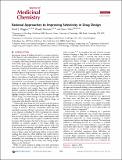Rational Approaches to Improving Selectivity in Drug Design
Author(s)
Huggins, David J.; Sherman, Woody; Tidor, Bruce
DownloadTidor_Rational approaches.pdf (9.350Mb)
PUBLISHER_POLICY
Publisher Policy
Article is made available in accordance with the publisher's policy and may be subject to US copyright law. Please refer to the publisher's site for terms of use.
Terms of use
Metadata
Show full item recordAbstract
Appropriate tuning of binding selectivity is a primary objective
in the discovery and optimization of a compound on the path
toward developing a drug. The environment in which drugs act
is complex, with many potential interaction partners. Proteins,
DNA, RNA, lipids, sugars, metabolites, and other small molecules
all have the potential to interact with a drug, and in many
cases these unexpected interactions lead to undesired and often
severe side effects. Conversely, the ability to interact with
multiple targets or drug resistance mutants can be advantageous
in certain contexts. Designing a drug with the appropriate
balance of avoidance of undesirable targets (narrow selectivity)
and coverage of one or more targets of interest (broad selectivity,
also referred to as promiscuity) is a continual drug development
challenge. In many cases this objective is attained through trial
and error, but there are rational approaches that can guide the
tuning of selectivity, and examples have been published that
illustrate a number of generalizable strategies. In this review, we
discuss fundamental principles that account for selectivity and
highlight examples where selectivity has been attained through
rational design. An understanding of the general principles that
drive selectivity should allow for more efficient design of
compounds with desirable selectivity profiles.
Date issued
2012-01Department
Massachusetts Institute of Technology. Computer Science and Artificial Intelligence Laboratory; Massachusetts Institute of Technology. Department of Electrical Engineering and Computer Science; Whitehead Institute for Biomedical ResearchJournal
Journal of Medicinal Chemistry
Publisher
American Chemical Society (ACS)
Citation
Huggins, David J., Woody Sherman, and Bruce Tidor. “Rational Approaches to Improving Selectivity in Drug Design.” Journal of Medicinal Chemistry 55.4 (2012): 1424–1444. Copyright © 2012 American Chemical Society
Version: Final published version
ISSN
0022-2623
1520-4804